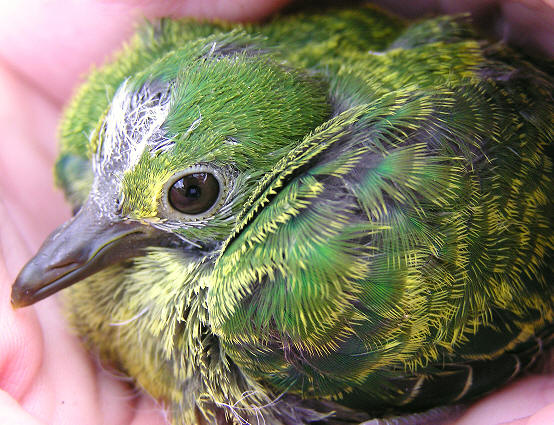Rota Avian Behavioral Ecology ProgramUniversity of Washington, Psychology Department |
||
Home • The Team • The Research • The Island • The Birds • Photos • Links • Sarah's Blog |
||
 |
Bird Survey AnalysesAnalyses of survey data indicate significant declines in the populations of
several native species on Rota, while increases have been identified for the introduced black drongo and for two native cavity nesters in one or more habitat types. An analysis of a change over time across stations has not indicated any specific geographic problem areas or hotspots of localized decline on the island. Population Viability AnalysesUsing 97 birds marked and resighted over the course of a 21 year period, we showed there was a rapid decline in first-year (fledgling to one year old) survival from 0.7 to 0.4 between 1990 and 2010, representing a doubling in mortality, and a smaller reduction in adult survival from 0.86 to 0.82 over the same period. A population model based on Leslie matrices incorporated the effects of catastrophic events, such as typhoons and human nest removal for captive breeding. All simulations predicted a precipitous decline in future populations and the inclusion of nest removals only shortened the life of the wild population by a few years. Typhoon AnalysesWe have completed analyses of the relationship between typhoons and avian abundance on Rota using BBS and VCP data (currently being reviewed by Micronesica). Radio Telemetry and Resight AnalysesWe developed a GIS data set of fledging
crow movements and are currently analyzing home range and dispersal
statistics. We also conducted an age and sex specific mortality
analyses based on mark-resight data. Nest Site SelectionWe examined 55 actual nest sites and 60 random sites from 1997 to 1999 to investigate habitat characteristics specific to crow nest sites. Both nests and random plots were predominantly in
limestone forest habitat. Nests in native forests were associated with higher reproductive success than nests in more disturbed areas. These findings suggest that damage to habitat from anthropogenic or natural causes may be limiting nesting success. Distribution and Breeding AnalysesWe examined data on breeding performance collected from 1996-2009 for the Mariana crow. We estimate the current population size at 120 breeding adults, a decline of more than 50% since 1999. Losses of breeding pairs have not been uniform across the island. We found that nesting success has been significantly lower in recent years than in the first years when nest data was collected, although there is not a consistent decreasing trend over time. Breeding takes place year round, and nesting success is correlated with rainfall. Nest success, like breeding pair
survival, varies across the island, possibly due to differences in nest predation rates. Aga are capable of nesting up to three times a year, with comparable breeding success on each nesting
attempt. We suggest a program of habitat maintenance, removal of invasive predators, and captive rearing to restore the Aga population on Rota to viable levels. This paper is under review by co-authors just prior to submission. White-eye ResearchSpecies Census and Invertebrate SamplingInvertebrate sampling was begun in summer 2006 to determine prey availability in bridled white-eye habitat. Analysis is currently underway. We are also looking at the effects of habitat changes over time on this population. Nest PredationEight nests were monitored from 2003 to 2005, half of which were successful in producing at least one fledgling. The average clutch size was 2 (n = 5) and the average number of fledglings from successful nests was 1.4 (n = 4). We filmed six of these nests and captured two nest predation events on video. A Mariana Crow (Corvus kubaryi), another endangered species, was filmed taking nestlings from one white-eye nest. Another nest containing eggs was depredated by a Pacific rat (Rattus exulans). |
|
| Back to top | ||
Problems with this website? Contact jcha@u.washington.edu |
Home • The Team • The Research • The Island • The Birds • Photos • Links |
|